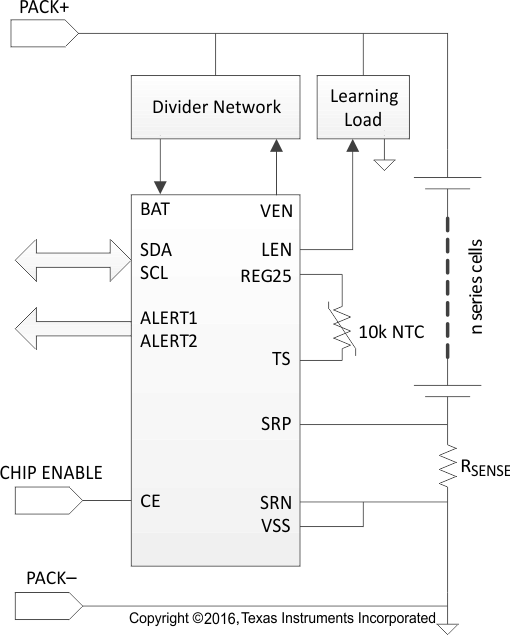SLUSCI1B August 2016 – November 2016
PRODUCTION DATA.
- 1 Features
- 2 Applications
- 3 Description
- 4 Revision History
- 5 Pin Configuration and Functions
-
6 Specifications
- 6.1 Absolute Maximum Ratings
- 6.2 ESD Ratings
- 6.3 Recommended Operating Conditions
- 6.4 Thermal Information
- 6.5 Electrical Characteristics: Supply Current
- 6.6 Electrical Characteristics: Digital Input and Output DC Characteristics
- 6.7 Electrical Characteristics: Power-On Reset
- 6.8 Electrical Characteristics: LDO Regulator
- 6.9 Electrical Characteristics: Internal Temperature Sensor
- 6.10 Electrical Characteristics: Low-Frequency Clock Oscillator
- 6.11 Electrical Characteristics: High-Frequency Clock Oscillator
- 6.12 Electrical Characteristics: Integrating ADC (Coulomb Counter)
- 6.13 Electrical Characteristics: ADC (Temperature and Voltage Measurements)
- 6.14 Electrical Characteristics: Data Flash Memory
- 6.15 Timing Requirements: I2C-Compatible Interface Timing Characteristics
- 6.16 Typical Characteristics
- 7 Detailed Description
- 8 Application and Implementation
- 9 Power Supply Recommendations
- 10Layout
- 11Device and Documentation Support
- 12Mechanical, Packaging, and Orderable Information
Package Options
Mechanical Data (Package|Pins)
- PW|14
Thermal pad, mechanical data (Package|Pins)
Orderable Information
1 Features
- Accurate End-Of-Service (EOS) Determination for Batteries in Rarely Discharged Applications
- Compensated End-of-Discharge Voltage (CEDV) Gas Gauge for Single- and Multi-Cell Batteries, Providing
- State-Of-Charge (SOC)
- Time-To-Empty (TTE)
- State-Of-Health (SOH)
- Watt-Hour–Based Charge Termination
- Supports Voltages up to 65 V, Capacities up to 32 Ah, and Currents up to 32 A—with Options to Extend Beyond These Levels Using Scaling
- Supports Li-Ion, LiFePO4, Lead-Acid (PbA), NiMH, and NiCd Chemistries
- Dual Configurable Host Interrupt or GPO
- Lifetime Data Logging Options
- Precision Coulomb Counter, Voltage, and Temperature Measurement
- Power Enable Control
- I2C™ Communication with Host
- Accumulated Charge Coulomb Counting with Configurable Interrupt
- SHA-1 Authentication
2 Applications
- UPS Backup Systems
- Telematics Backup Systems
- Emergency Battery Power Modules
- Energy Storage Systems
- Asset Tracking
- Building Security Systems
- Video Surveillance
- Electronic Smart Locks
- Remote and Emergency Lighting
- Server Power Systems
- Robotics
- Toys
3 Description
The bq34110 CEDV Battery Gas Gauge provides CEDV gas gauging and End-Of-Service (EOS) Determination for single- and multi-cell batteries. The device includes enhanced features to support applications where the battery is kept fully charged and is rarely discharged, such as found in a wide variety of backup systems. The bq34110 gas gauge supports multiple battery chemistries, including Li-Ion and LiFePO4, lead acid (PbA), Nickel Metal Hydride (NiMH), and Nickel Cadmium (NiCd).
The gas gauging function uses voltage, current, and temperature data with Compensated End-of-Discharge Voltage (CEDV) technology to provide State-Of-Charge (SOC) and State-Of-Health (SOH) data. The gas gauge also incorporates an End-Of-Service (EOS) Determination function that alerts when battery capability has degraded and is approaching the conclusion of its usable service.
The data available from the gauge can be read by the host through a 400-kHz I2C bus. Two ALERT outputs are also available to interrupt the host or can be used for other functions, based on a variety of configurable options.
Device Information(1)
| PART NUMBER | PACKAGE | BODY SIZE (NOM) |
|---|---|---|
| bq34110 | TSSOP (14) | 5.00 mm × 4.40 mm |
- For all available packages, see the orderable addendum at the end of the data sheet.
Simplified Schematic

4 Revision History
| DATE | REVISION | NOTES |
|---|---|---|
| November 2016 | B | PRODUCT PREVIEW to Production Data |